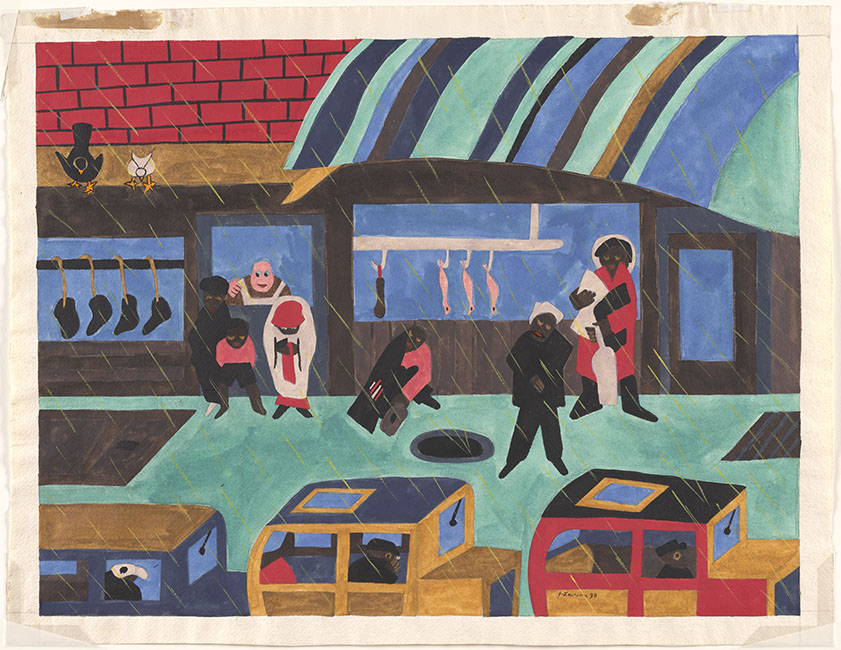Back in June, I wrote about Jacob Lawrence’s silkscreen practice, relating it to his long-running immersion in Black life and history. At the time, I wanted to write about the other work by Lawrence in the collection, Harlem Scene (The Butcher Shop), which is part of The Alfond Collection of Art. I held off, however, because the libraries were all closed, and I was missing access to some of the books that I hoped would help me solve a minor mystery about the painting. What is that mystery? Basically, the curatorial files indicated that the painting was dated 1942-3, but it is clearly signed and dated “Lawrence ‘38” in the lower right (visible in the rear quarter panel of the first car in the line that makes up the foreground of the painting). This discrepancy was enough to make me pause, though an old exhibition label in the files indicated that it was a second version of that earlier one, dated 1938.

Gouache on paper, 20 x 25 3/4 in., Image courtesy of the artist
The Alfond Collection of Art at Rollins College
Gift of Barbara ’68 and Theodore ’68 Alfond, 2017.15.3
I was right to wait. The mystery, it turns out, wasn’t a mystery at all, at least not to scholars of Lawrence and his work. All of my questions were answered this morning, when I finally got my hands on Jacob Lawrence: Paintings, Drawings, and Murals (1935-1999): a Catalogue Raisonné, the complete record of Lawrence’s work in those mediums up to 1999, the year before his death.1 A catalogue raisonné (often shorted to CR in the biz) is one of those great art historical tools that non-specialists might never have heard of, listing all of the known works by an artist, either in all mediums or, as is the case with Lawrence, particular mediums. They take an immense amount of research, often spanning the careers of multiple generations of art historians. For an idea of what one looks like, you can take a look at the wonderful online CR James McNeill Whistler: The Etchings, A Catalogue Raisonné, a collaboration among the University of Glasgow, the Art Institute of Chicago, and the Freer Gallery of Art.
In reading Jacob Lawrence: paintings, drawings, and murals (1935-1999): a catalogue raisonné, I learned that the painting in the CFAM collection is indeed a second version of a 1938 original, which was likely painted for the Federal Art Project of the Works Progress Administration, which supported American artists during the Great Depression.2 That work was subsequently damaged—a not unheard-of occurrence for Lawrence, whose gouache-on-paper works are more susceptible to damage than comparatively sturdy oils and acrylics on canvas—and returned to Lawrence, who painted a replacement.3 That is the painting that forms part of the Alfond Collection. As it happens, this was also the last Harlem painting which Lawrence painted before he began his wartime service in the Coast Guard, during which he played an instrumental role in attempts to integrate that branch of the U.S. Armed Forces.4 So, while there turned out to be no real mystery, I was rewarded for my patience with a good story to tell about an important painting, as well as a welcome reminder that an art historian is only as good as his tools.`
1 Peter T. Nesbett, Jacob Lawrence, and Michelle DuBois, Jacob Lawrence: Paintings, Drawings, and Murals (1935-1999): A Catalogue Raisonné (Seattle, WA: University of Washington Press in association with Jacob Lawrence Catalogue Raisonné Project, 2000). More-or-less complete, anyway. As the editors of the catalogue note, Lawrence was not as meticulous about record-keeping as some artists, so there may yet be works by him out there waiting to be rediscovered. There is an accompanying catalogue of his prints, as well. See Peter T. Nesbett and Patricia Hills, Jacob Lawrence: The Complete Prints (1963 – 2000) ; a Catalogue Raisonné, 2. ed (Seattle: Univ. of Washington Press, 2001).
2 Nesbett, Lawrence, and DuBois, Jacob Lawrence, 36.
3 Nesbett and Hills, Jacob Lawrence, 80.
4 For an excellent overview of that portion of Lawrence’s life, see John Ott, “Jacob Lawrence and the Desegregation of the Armed Forces and the Art World: Jacob Lawrence and the Desegregation of the Armed Forces and the Art World,” American Art 29, no. 3 (2015): 58–89.

